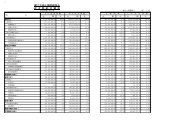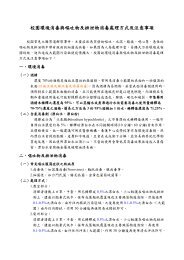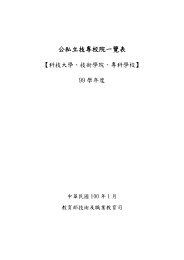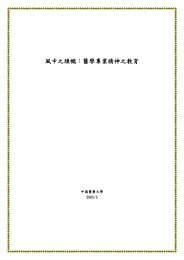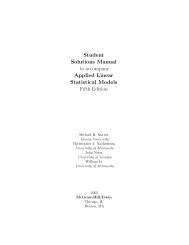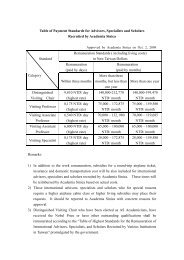Journal of Film Preservation - FIAF
Journal of Film Preservation - FIAF
Journal of Film Preservation - FIAF
Create successful ePaper yourself
Turn your PDF publications into a flip-book with our unique Google optimized e-Paper software.
Every copying has been an “interpretation” – from nitrate to safety, from<br />
orthochromatic to panchromatic film, from Technicolor, which is not made<br />
anymore, to similar colour formats, from VistaVision, which can’t be shown<br />
anymore, to ordinary 35mm. In the past the archives themselves – rumour<br />
has it – have copied from 35mm to 16mm, which they shouldn’t have done.<br />
What must be maintained is not the physical medium but the experience<br />
in the cinema.<br />
In some cases a digital restoration can assist in recreating the original<br />
cinematic experience, says Ge<strong>of</strong>f Andrew (BFI Southbank), among others:<br />
“For example, we have presented a colour-strong digital version <strong>of</strong> Gone<br />
with the Wind. It was without a doubt closer to the original version – to what<br />
the audience experienced in 1939 – than the 35mm copies that have been<br />
available in the last 30 years.” Other archivists are <strong>of</strong> the opinion that films<br />
must not only be kept in their original form but must also be shown in that<br />
form. They don’t want to present a digital version if a 35mm is available, or<br />
even if there is no longer any 35mm copy. “So many films have been lost in<br />
the annals <strong>of</strong> film history, so that I wouldn’t do. It is not about quality. All<br />
films are sharper now than before. A Dürer drawing can also be re-touched<br />
and made sharper than the original,” says Alexander Horwath. And Gabrielle<br />
Claes (Musée du Cinéma, Brussels) says: “The Museum <strong>of</strong> Cinema prefers to<br />
show a scratched and unsteady film print rather than a pristine DVD, with<br />
its clarity and steadiness, in the hopes <strong>of</strong> attracting audiences to the lively<br />
qualities <strong>of</strong> the original celluloid.” (Claes, p.26)<br />
It is a matter <strong>of</strong> common knowledge that we now have better digital formats<br />
than DVD, and the question is, <strong>of</strong> course, whether a good digital projection<br />
is not a better representation <strong>of</strong> the art <strong>of</strong> cinema than an incomplete,<br />
damaged, or badly projected 35mm or 16mm print. But to Alexander<br />
Horwath and others it is not, as mentioned, a question <strong>of</strong> “quality” but<br />
about maintaining the physical medium and engaging the audience in the<br />
experience <strong>of</strong> film as film. Thus future archives and cinematheques may<br />
become museums for a past medium and a resting place for the historical<br />
practice <strong>of</strong> watching film on 35mm in a cinema. Apart from dedicated<br />
musicians, almost nobody plays the harpsichord anymore, but you can<br />
enter a music museum and experience a harpsichord being played. “It’s at<br />
least one possibility I see for film museums, and I’d have no problem with it<br />
if it were to become a reality,” says Horwath.<br />
This article is based on conversations with:<br />
Ge<strong>of</strong>f Andrew (BFI Southbank, 24.10.07), Alexander Horwath (Österreichisches<br />
<strong>Film</strong>museum/Austrian <strong>Film</strong> Museum, Wien, 15.01.08), Laurent De Maertelaer (Musée<br />
du Cinéma, Bruxelles, 20.01.07), Jean-François Rauger (Cinémathèque Française, Paris,<br />
28.02.08), Rajendra Roy, Jytte Jensen, Joshua Siegel (The Museum <strong>of</strong> Modern Art,<br />
New York, 18.03.08), James Quandt, Andréa Picard (Cinematheque Ontario, Toronto,<br />
20.03.08), Edith Kramer, Susan Oxtoby, Kathy Geritz, Steve Seid, Mona Saitz (Pacific<br />
<strong>Film</strong> Archive, Berkeley, 24-25.03.08), Andrea Alsberg (UCLA <strong>Film</strong> & Television Archive,<br />
Los Angeles, 27.03.08), Gwen Deglise (American Cinematheque, Los Angeles, 28.03.08),<br />
Kjell Runar Jenssen (Cinemateket, Oslo, 22.04.08), Kajsa Hedström (Cinemateket,<br />
Stockholm, 24.04.08), Catherine Gautier (<strong>Film</strong>oteca Española, Madrid, 29.04.08), René Wolf<br />
(Nederlands <strong>Film</strong>museum, Amsterdam, 02.05.08). Where nothing else is cited, the quotes are<br />
from these conversations.<br />
23 <strong>Journal</strong> <strong>of</strong> <strong>Film</strong> <strong>Preservation</strong> / 81 / 2009



